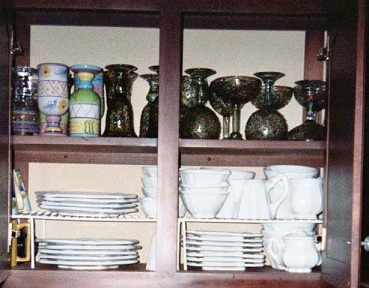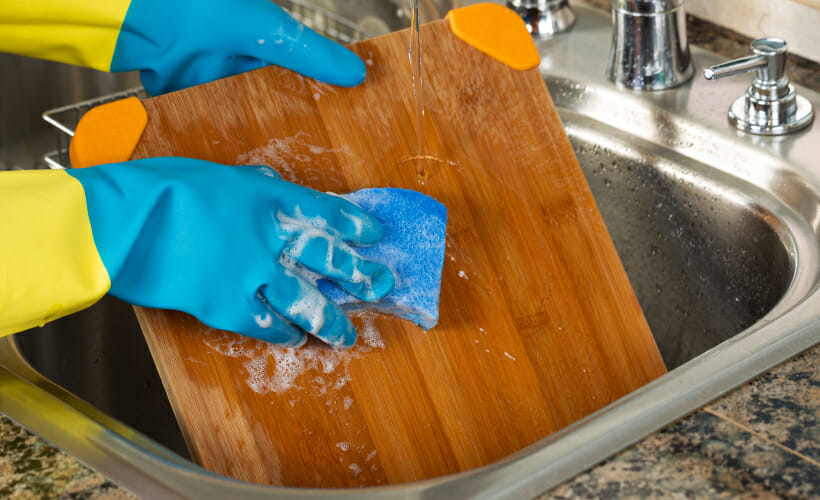Clean Dishes Must Before They Are Stored
However most of us can recall walking into a cafeteria and pulling a wet plate from. To clean your non-stick items gently scrub them with a 11 ratio of baking soda and water and a plastic brush or scrubbing pad.

Organize Your Kitchen Genius Ideas For Your Most Used Room Kitchen Hacks Organization Diy Kitchen Storage Cool Kitchens
One way to do that is to ______.

. Scrape away leftover food on the dishes and utensils. Wash dish cloths often in the hot cycle of your washing machine. Now that you know the best way to clean dishes you might be ready to move on to other parts of the kitchen.
Foodhandlers must tell their managers when they have which symptom. If you defrost raw meat or fish and then cook it thoroughly you can freeze it again but remember never reheat foods more than once. If you dont want to use hot water.
Purchase modular square containers. If you dont wash it its really really low risk. There should be two designated areas around the dishwashing area.
His Washington Post article cites research from the EPA the Natural Resources Defense Council and the American Council. The thorough cleaning of eating and drinking utensils and food contact surfaces is a critical step before sanitising. Wash fruits and vegetables but not meat poultry or eggs.
This is a 4 step process that removes food waste dirt grease and destroys food-borne disease pathogens. Washed rinsed and sanitized. Customers forks should be stored at a self-service buffet______.
Step 1Remove food or crumbs. Neststack them together. A place for dirty dishes and a large area for clean dishes to be stored.
Do not stack wet dishes. This is because dirty damp cloths allow bacteria to breed. Wash cutting boards dishes utensils and countertops with hot soapy water especially after theyve held raw meat poultry seafood or eggs.
Rinse in clear water after washing. Wash or change dish cloths tea towels sponges and oven gloves regularly. Create a master cleaning schedule.
Chapman both camps are right. Take care to keep all utensils and dishes clean before preparing food. Cleaning kitchen items Dish cloths.
Utensils and serving dishes. Follow these steps to keep these hard surfaces clean and free from germs. They need to be exposed to air in order to dry properly.
Always clean plates utensils surfaces and hands thoroughly after they have touched raw or thawing meat to stop bacteria from spreading. This invites cross-contamination and is an excellent opportunity to mistake a dirty dish for a clean one. Step 3Make a disinfecting chlorine solution of ¼ cup of household chlorine bleach.
Run the hot water in the sink before turning the dishwasher on to prevent the cycle from starting with cold water. Add dish soap to the water in the amount recommended on the instruction label. Use a brush if necessary.
Step 2Wash with hot soapy water and rinse with a clean dishcloth. Chis Mooney has written up the current research on dishwashing efficiency. A food code developed by the FDA specifies that all dishes should be air-dried before being stacked and stored.
With only the handles extending out of the container. Place items in a wire basket or other container and immerse them in a sanitizing solution. Food businesses must use a cleaning process that ensures the utensil or food contact surface looks clean feels clean and smells clean.
Wash dishes pots pans and utensils and detached parts in hot soapy water. If wearing gloves either wash them or put on a clean pair. Its important to let them dry before you use them again.
Effective cleaning For effective cleaning the following factors should be considered. Initially most cleaning detergents contained phosphates. For optimal drying all.
Be sure the other side of a double sink is clean and available for rinsing or prepare a dishpan of rinse water. Never put dirty dishes in the clean dish area. Rinse the dishes and utensils in the second sink with clear clean water.
Using a kitchen cleaning checklist. This resulted in sparkling clean utensils. Pathogens grow well between which temperatures.
As pointed out in an article in The Wall Street Journal you arent supposed to pre-rinse your dishes before putting them in the machine. Phosphates helped to prevent the formation of white film on dishes and glassware in the dishwasher by chelating calcium and magnesium ions. Do not let water pool up in the bottom of glasses bowls or cups.
Remove detachable parts such as blades plastic or wooden handles and screens. But you knew there would be a but during the manufacturing process there might be some plastic or other materials that are placed in appliances like plastic sheeting or dust from warehouse Dr. Clean the dishes and utensils in the first sink with soap and warm water.
Stack the lids on the same shelf in the same cabinet vertically in a big container. Experts at the health organization say that you need to thoroughly rinse or completely submerge your dishes for at least 30 seconds in order to kill any harmful germs. Before use a thermometer must be.
Run a Sink or Dishpan of Hot Water. Because theyre square they fit in the cabinet easily stack easily and theyre the perfect size for food storage. Storing dry food in containers.
To wash and sanitize. According to Dr. 41 F and 135 F 5 C and 57 C which food item needs time and temperature control to keep it safe.
The Code does not specify which procedures must be used to ensure the premises and equipment are kept in a clean and sanitary condition. If you want to to properly clean your dishes for optimal safety be sure to have a good pair of kitchen gloves and possibly a thermometer. Sanitize the dishes and utensils in a chemical solution or very hot water at least 171F in the third sink.
Store glasses and cups upside-down so that they dry properly and dust does not accumulate inside. Food service managers must oversee safe food practices at all times. Always wash hands before handling clean dishes.
All items that come into contact with food must be effectively cleaned and sanitised. Hot water at the hand sink should be at least ________. However in 2010 the use of phosphates in detergents was banned since they were found to remain in wastewater.
Place the stopper in the sink and run water as hot as is still comfortable until it is half full.

31 Creative Ways To Store Dishes And Utensils That Go Beyond Cabinetry Diy Kitchen Cabinets Kitchen Design Rustic Kitchen

Storing China Dishes Whats Cooking America

22 Brilliant Ideas For Organizing Kitchen Cabinets Diy Kitchen Storage Kitchen Inspirations Kitchen Storage

How To Sanitize Dishes Food Safety When Cleaning And Drying Dishes
No comments for "Clean Dishes Must Before They Are Stored"
Post a Comment